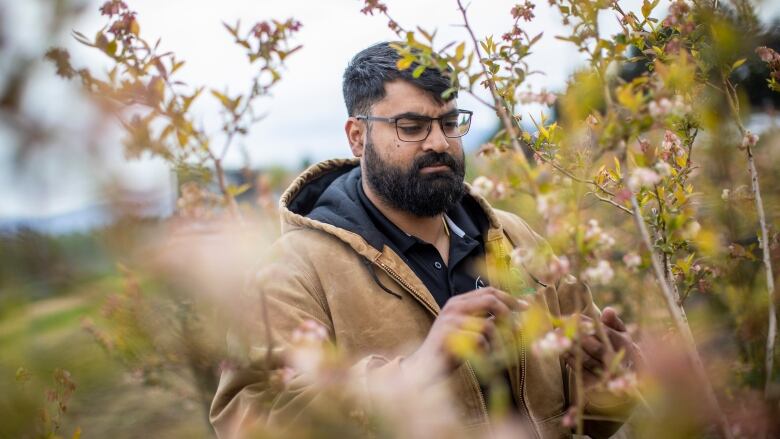Historically cold spring deals another blow to B.C. farmers as crops lag
Below average temperatures in April and May means Fraser Valley crops several weeks behind

Sajan Mandair walks through rows of strawberry plants at his Abbotsford, B.C., farm, butjust a few of them are starting to flower a sign that they're several weeks behind in their growth cycle.
"It's been a challenge because of the cold weather," he said. "It's really stunted the growth of all the plants and it's really slowed down the season for us."
Excess rainfall has also made it harder to work infields and plant because of the mud.
"It'll be sunny for a day or two and once you get everything ready to go with your tractors, it's raining again," said Mandair. "We've been a little bit late on planting this year."

Farmers in the Fraser Valley are grappling with temperatures 2 C below the seasonal average, which has set a number of crops including blueberries, strawberriesand raspberries about threeweeks behind their usual schedule.
The delays could prove costly for farmers like Mandair, who fearthe slow downwill result in greater competition from international growers comeharvest time.
"We need to get the local supply into the market place," he said. "If we don't do that, there's other countries that come in and they're able to take that market share."
Cooler temperatures
Cool weather isjust the latest challengefarmers in the regionare grappling with. Many still haven't recovered fromthe aftermath of both the heat dome and historic flooding last year, and exceptionally high fuel prices, which are driving up operating costs.
"We just can't seem to catch a break," said Lenore Newman, the director of the Food and Agriculture Institute at University of Fraser Valley.
"It's been steady with heat domes and floods and fires, and now it's too cold and it is significantly too cold."

B.C. set record-breaking temperaturesfor the coldest and latest afternoon highs in May, said CBC News meteorologist Johanna Wagstaffe.
She also forecast May to stay chilly.
"The outlook for the second half of May is still cool. We're still under the influence of La Nina, so likely our averagetemperatures will come in below seasonal over the next few weeks," said Wagstaffe.
'Increasingly unpredictable'
Newman says the colder than normal farming season, coupled with ongoingclimate disasters, highlight a need to grow more food indoors under more predictable conditions.
"It's not a cure all ... but as the climate becomes increasingly unpredictable, we are going to see more crops growing indoors and we're also going to see crops grown here that we used to import," she said.
Newman said that California is losing agricultural land due to drought and heat, meaning other regions, like B.C.may have to take on growing what California can't.
Farmers like Mandair, are already investing in measures to help them grow undermore unpredictable conditions.He has put in place protective high tunnels,known as hoop houses, for some of his crops.

"We have to figure out a way not to rely on all these other elements," he said. "That's why I'm trying to do all these different hoop houses, trying to do other ways to produce, and try to cut the variables out."
In the meantime, with many producers in the valley still recovering from the heat dome, and floods,Mandair saidit's more important than ever to support local farmers to ensure revenues.
He said farmers are working hard to grow food locally.
"All of us farmers want to supply the market ... the population's growing, and we need to produce food for our people."












_(720p).jpg)


 OFFICIAL HD MUSIC VIDEO.jpg)
.jpg)



























































































